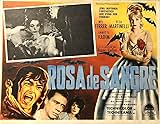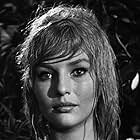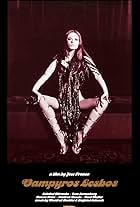IMDb RATING
6.5/10
1.5K
YOUR RATING
A young heiress - jealous of her cousin's engagement to another woman - becomes obsessed with the legend of a vampire ancestor, who supposedly murdered the young brides of the man she loved.A young heiress - jealous of her cousin's engagement to another woman - becomes obsessed with the legend of a vampire ancestor, who supposedly murdered the young brides of the man she loved.A young heiress - jealous of her cousin's engagement to another woman - becomes obsessed with the legend of a vampire ancestor, who supposedly murdered the young brides of the man she loved.
Annette Stroyberg
- Carmilla
- (as Annette Vadim)
René-Jean Chauffard
- Dr. Verari
- (as R.J. Chauffard)
Gabriella Farinon
- Lisa
- (as Gaby Farinon)
Edith Peters
- The Cook
- (as Edith Arlene Peters Catalano)
Nathalie Lafaurie
- Marie
- (as Nathalie LaFaurie)
Carmilla Stroyberg
- Martha
- (as Camilla Stroyberg)
Giovanni Di Benedetto
- Police Marshal
- (uncredited)
Renato Speziali
- Guido Naldi
- (uncredited)
Roger Vadim
- Passenger in the Plane
- (uncredited)
Storyline
Did you know
- TriviaChristopher Lee was originally considered for the role of Count Karnestein (probably to make the film marketable for fans of his Hammer vampire films) but the part eventually went to his friend Mel Ferrer.
- GoofsIn three shots from the same scene, the bloodstain on Carmilla's dress moves from the right to the left side, then back to the right side again.
- Alternate versionsThe US version of the film eliminates both the original epilogue and prologue as the Professor tells the story of Carmilla, as well as almost every scene with Martha and Marie. That version also includes a totally different ending on which Georgia herself becomes a vampire, as well as an all new voice over narration by Millarca herself.
- ConnectionsFeatured in Aweful Movies with Deadly Earnest: Blood and Roses (1975)
Featured review
Joseph Sheridan Le Fanu’s classic horror short story “Carmilla” (which I own and have read) spearheaded the trend for cinematic tales of lesbian vampires. This is the second film adaptation of it – the first, a very loose one, was Carl Theodor Dreyer’s magnificent VAMPYR (1931; soon to be regaled with two fully-loaded SE DVDs on both sides of the Atlantic) and it was followed in quick succession by the Spanish/Italian co-production CRYPT OF THE VAMPIRE (1963; starring Christopher Lee, a quite good version, of which I foolishly erased a VHS copy I had recorded off Italian TV – the only edition currently available is the Retromedia R1 DVD which, unfortunately, presents the film dubbed in English), the Amicus/Hammer collaboration THE VAMPIRE LOVERS (1970; starring Ingrid Pitt and Peter Cushing) and Vicente Aranda’s eerily erotic THE BLOOD-SPATTERED BRIDE (1972).
Director Vadim is better-known for having had great tastes in women (counting Brigitte Bardot, Catherine Deneuve and Jane Fonda among his discoveries/lovers) than for his film-making talents; I myself have only been truly impressed by one of his movies – THE GAME IS OVER (1966) – out of the seven that I’ve watched so far (including this one). BLOOD AND ROSES could well have been the second…were it not for the fact that the edited 74-minute version I watched – prepared for U.S. home video consumption and sporting the Anglicized original title AND DIE OF PLEASURE – is a bit of a mess (the full-length French version is 87 minutes long), English-dubbed (naturally), panned-and-scanned (of course), and preceded by one of the phoniest credit sequences I’ve ever witnessed (that said, a reasonable photo gallery was included with the DivX copy I acquired, which starts automatically soon after the main feature). Needless to say, I’d long wanted to watch this – but, bearing in mind the state of the edition I ended up with, in spite of its many pictorial rewards, it wasn’t an ideal viewing experience…and one can only hope that, given the amicable relationship between Paramount (who owns the U.S. rights for BLOOD AND ROSES) and Criterion, the film will turn up someday – in the original French language and uncut – on a decent official DVD (after all, the latter’s vast and considerable collection already numbers Vadim’s debut feature …AND GOD CREATED WOMAN [1956] among its releases).
Anyway, the cast is an interesting combination of international movie stars (Mel Ferrer – who, coincidentally, has just died aged 90 – and Elsa Martinelli), newcomers (Annette Vadim nee' Stroyberg) and even a director (Marc Allegret, who had given Vadim an early start when he engaged him as his assistant). The film makes a fair attempt to update the LeFanu original to contemporary times – though, rather than make Carmilla and Millarca one and the same, we get the former being possessed by the latter: this is quite subtly done (at least in this reduced form) as Millarca’s personality in Carmilla manifests itself in her suddenly knowing the steps to an ancient dance and her incongruous preference for a classical record! As a matter of fact, this medieval quality permeates the whole film – thanks also to Jean Prodromides’ haunting melancholy score (which is then effectively speeded-up during the ‘horror’ sequences). Incidentally, the film was clearly intended for the Art-house crowd (resulting in being fairly talky for the first two-thirds) – even if it’s not quite in the same league as Georges Franju’s EYES WITHOUT A FACE (1959), an altogether more accomplished and successful marriage of the highbrow and the exploitative.
That said, it contains any number of striking sequences: the costume party (with a fireworks display for backdrop) in which Ferrer dons a bat mask fitted with a pair of wings!; Stroyberg’s wraith-like pursuit of her first victim (her stilted performance is actually just right for the character) – despite its being obviously shot day-for-night; the wilted rose on Carmilla’s white dress turning to a huge blood stain (incidentally, this vampire registers in a mirror!); Stroyberg’s seduction of Martinelli on a rainy night inside the Karnstein family greenhouse (both women also love Ferrer, though he and Stroyberg are related!); Martinelli’s surreal, erotic and blood-spattered black-and-white dream sequence towards the end (in which, among other things, Stroyberg as Millarca operates on her naked self as Carmilla!) – which is the film’s undeniable tour-de-force; Carmilla’s demise as she gets staked during an explosion (the location being a cemetery holding remnant shells from WWII); and the very last image when another wilted rose betrays the fact to the audience, but not the oblivious Ferrer, that Martinelli has herself been turned into a vampire (the latter starts off as an ingénue but slowly, and believably, matures through her attachment to Carmilla).
By the way, some weeks back I happened upon a recent TV interview with Martinelli; she seemed deservedly proud of her cinematic legacy (including a successful stint in Hollywood) but, unsurprisingly, this film – or another good one where she was also involved in lesbianism, Lucio Fulci’s giallo ONE ON TOP OF THE OTHER aka PERVERSION STORY (1969) – wasn’t mentioned at all…
Director Vadim is better-known for having had great tastes in women (counting Brigitte Bardot, Catherine Deneuve and Jane Fonda among his discoveries/lovers) than for his film-making talents; I myself have only been truly impressed by one of his movies – THE GAME IS OVER (1966) – out of the seven that I’ve watched so far (including this one). BLOOD AND ROSES could well have been the second…were it not for the fact that the edited 74-minute version I watched – prepared for U.S. home video consumption and sporting the Anglicized original title AND DIE OF PLEASURE – is a bit of a mess (the full-length French version is 87 minutes long), English-dubbed (naturally), panned-and-scanned (of course), and preceded by one of the phoniest credit sequences I’ve ever witnessed (that said, a reasonable photo gallery was included with the DivX copy I acquired, which starts automatically soon after the main feature). Needless to say, I’d long wanted to watch this – but, bearing in mind the state of the edition I ended up with, in spite of its many pictorial rewards, it wasn’t an ideal viewing experience…and one can only hope that, given the amicable relationship between Paramount (who owns the U.S. rights for BLOOD AND ROSES) and Criterion, the film will turn up someday – in the original French language and uncut – on a decent official DVD (after all, the latter’s vast and considerable collection already numbers Vadim’s debut feature …AND GOD CREATED WOMAN [1956] among its releases).
Anyway, the cast is an interesting combination of international movie stars (Mel Ferrer – who, coincidentally, has just died aged 90 – and Elsa Martinelli), newcomers (Annette Vadim nee' Stroyberg) and even a director (Marc Allegret, who had given Vadim an early start when he engaged him as his assistant). The film makes a fair attempt to update the LeFanu original to contemporary times – though, rather than make Carmilla and Millarca one and the same, we get the former being possessed by the latter: this is quite subtly done (at least in this reduced form) as Millarca’s personality in Carmilla manifests itself in her suddenly knowing the steps to an ancient dance and her incongruous preference for a classical record! As a matter of fact, this medieval quality permeates the whole film – thanks also to Jean Prodromides’ haunting melancholy score (which is then effectively speeded-up during the ‘horror’ sequences). Incidentally, the film was clearly intended for the Art-house crowd (resulting in being fairly talky for the first two-thirds) – even if it’s not quite in the same league as Georges Franju’s EYES WITHOUT A FACE (1959), an altogether more accomplished and successful marriage of the highbrow and the exploitative.
That said, it contains any number of striking sequences: the costume party (with a fireworks display for backdrop) in which Ferrer dons a bat mask fitted with a pair of wings!; Stroyberg’s wraith-like pursuit of her first victim (her stilted performance is actually just right for the character) – despite its being obviously shot day-for-night; the wilted rose on Carmilla’s white dress turning to a huge blood stain (incidentally, this vampire registers in a mirror!); Stroyberg’s seduction of Martinelli on a rainy night inside the Karnstein family greenhouse (both women also love Ferrer, though he and Stroyberg are related!); Martinelli’s surreal, erotic and blood-spattered black-and-white dream sequence towards the end (in which, among other things, Stroyberg as Millarca operates on her naked self as Carmilla!) – which is the film’s undeniable tour-de-force; Carmilla’s demise as she gets staked during an explosion (the location being a cemetery holding remnant shells from WWII); and the very last image when another wilted rose betrays the fact to the audience, but not the oblivious Ferrer, that Martinelli has herself been turned into a vampire (the latter starts off as an ingénue but slowly, and believably, matures through her attachment to Carmilla).
By the way, some weeks back I happened upon a recent TV interview with Martinelli; she seemed deservedly proud of her cinematic legacy (including a successful stint in Hollywood) but, unsurprisingly, this film – or another good one where she was also involved in lesbianism, Lucio Fulci’s giallo ONE ON TOP OF THE OTHER aka PERVERSION STORY (1969) – wasn’t mentioned at all…
- Bunuel1976
- Jun 4, 2008
- Permalink
- How long is Blood and Roses?Powered by Alexa
Details
- Runtime1 hour 14 minutes
- Aspect ratio
- 2.35 : 1
Contribute to this page
Suggest an edit or add missing content


























